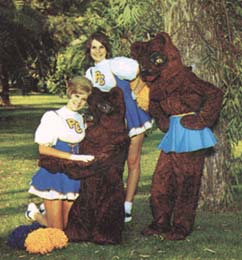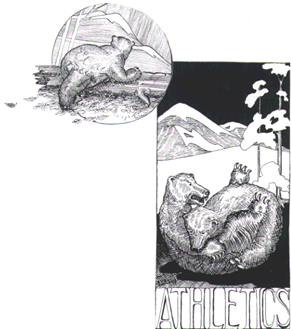Mascot Bumstead Once Roamed Campus
Joe Gacioch
Bear Tracks May 6, 1966
A circus came to Phoenix about 1920, nobody seems to remember which one; and a mama black bear, a conspicuous part of the troupe, brought a little cub into the world. Somebody, but nobody remembers who, convinced the circus owners that it would be better to leave the cub behind in the custody of Phoenix Junior College -- the newest and only junior college in Phoenix.
 PJC now had a frisky mascot and the athletic teams took the name "the Bear." Two heavy chain leashes were fastened to the leather collar and the cub came to all the early football cames with an escort on each side. The black cub was a living example of school spirit. Almost by instinct, he knew when the going was rough on the grid and would stand on his haunches and bellow.
PJC now had a frisky mascot and the athletic teams took the name "the Bear." Two heavy chain leashes were fastened to the leather collar and the cub came to all the early football cames with an escort on each side. The black cub was a living example of school spirit. Almost by instinct, he knew when the going was rough on the grid and would stand on his haunches and bellow.
Ths little bear was a novelty. There was no "wildcat" at the college in Tucson; and the people in Tempe failed to present reasonable facsimile of Lucifer. The crowds cheered him and the teams pampered him. He was a real mascot.
It seems that the student body forgot that he was a living thing with a capacity for growth, for when classes convened the following year, everyone was astonished at the size of the full-grown black bear.
He still went to the games; but he was much harder to control. He knew, as if by instinct, when PJC had to fight harder and would often strain at his chains determined to enter the melee. Reluctantly, the students and administration realized that the black bear was no longer able to come to the games and they concluded that he might be happier somewhere else -- perhaps with his mother in the circus, or in a zoo.
The bear was gone now, but the students had need of a mascot, or at least a symbol of one; and they found him.
The Igloo Ice Cream Parlor was an igloo-shaped building on the east side of 7th Street across from Phoenix Union High School. It featured as part of its decoration a plaster bear. From 1925-1927, almost always before an important event or crucial game, but sometimes for the mere devilment of it, PJC students would "borrow" the bear and bring him on campus.
The Igloo Ice Cream Parlor would send notice by mail to the administration that their bear was missing--again, and request the help of the students to find him. This action took longer than a telephone conversation and gave students a day or two to "search" for the bear.
 In 1931 a student named Don Marquess obtained a "Zerolene" bear from the Standard Oil Company. Standard Oil company used the 900 pound, concrete and porcelain statue to advertise Zerolene Oil. Now the college had a permanent bear, but no name for him. Dr. Joseph Smelser recalls that Gertrude Mach, a student, christened the bear Bumstead in 1935.
In 1931 a student named Don Marquess obtained a "Zerolene" bear from the Standard Oil Company. Standard Oil company used the 900 pound, concrete and porcelain statue to advertise Zerolene Oil. Now the college had a permanent bear, but no name for him. Dr. Joseph Smelser recalls that Gertrude Mach, a student, christened the bear Bumstead in 1935.
Bumstead was moved to the quadrangle, the area in front of the Auditorium where the new library is located, in 1939. He was close to the flagpole and sat on an octagonal shaped pedestal close to many school ceremonies. Bumstead was a school tradition.
Vandals had attacked Bumstead before 1947, (he had been tarred and feathered, painted, and stolen), but in November of that year, he was decapitated with a sledge hammer; and the American flag and its pole was detroyed with a stick of dynamite.
The Flagpole incident is still vivid to Dr. Smelser. "It was a Saturday night. My wife and I had just stepped out of the Auditorium during the intermission of the play inside. I heard an enormous explosion." The vandals were never caught.
The students were angry at the sight of a beheaded Bumstead, but vented their anger on a reconstruction project for him. Richard Rogers, a student, proposed to mount a new head on Bumstead, but a faculty committee appointed to study the problem said it would be impossible. Rogers and Dr. Virginia Botsford searched for weeks to find a suitable replacement for the statue; and were successful at Desert Wells, Arizona.
T.J. Forman of Desert Wells helped Miss Botsford and Rogers secure the plaster smaller-than-Bumstead bear for Phoenix College. Rogers and Eldon Hamblin, another student, made a mold of the new statue and took it to E.M. Adams of the Arizona Iron Works to case the statue in a strong aluminum and steel alloy.
While the bear was being molded, it was discovered that Bumstead could be repaired. Mrs. Madeline Blake, Mr. Amos Hoff, and a student, Richard Hoff (no relation), placed the new head on Bumstead's shoulders. "It worked," said Mr. Hoff, "but shortly after he was repaired Bumstead was attacked again and broken into many more pieces."
Angered by the second attack on Bumstead, Harland Radfield, a student, contributed to the May 14, 1948 edition of "Bear Tracks" an elegaic poem, "The Rape of The Bear." It seems that it was decided to do away with the physical image of a bear.
<
Part of the Phoenix College website.
Rendered on 8/12/98.